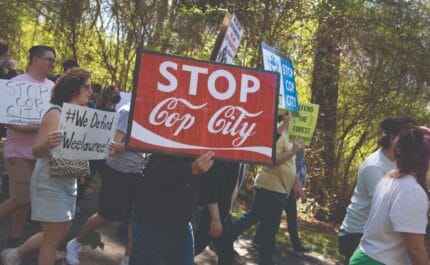Zaatari: the Syrian city in exile
What started out as temporary shelter for those fleeing the Syrian civil war has grown into a fully functioning city, which at one point was the fourth largest refugee camp in the world. Sakhr Al-Makhadhi tells the incredible story of Jordan’s Zaatari settlement and asks what it reveals about the failures of the Arab Spring
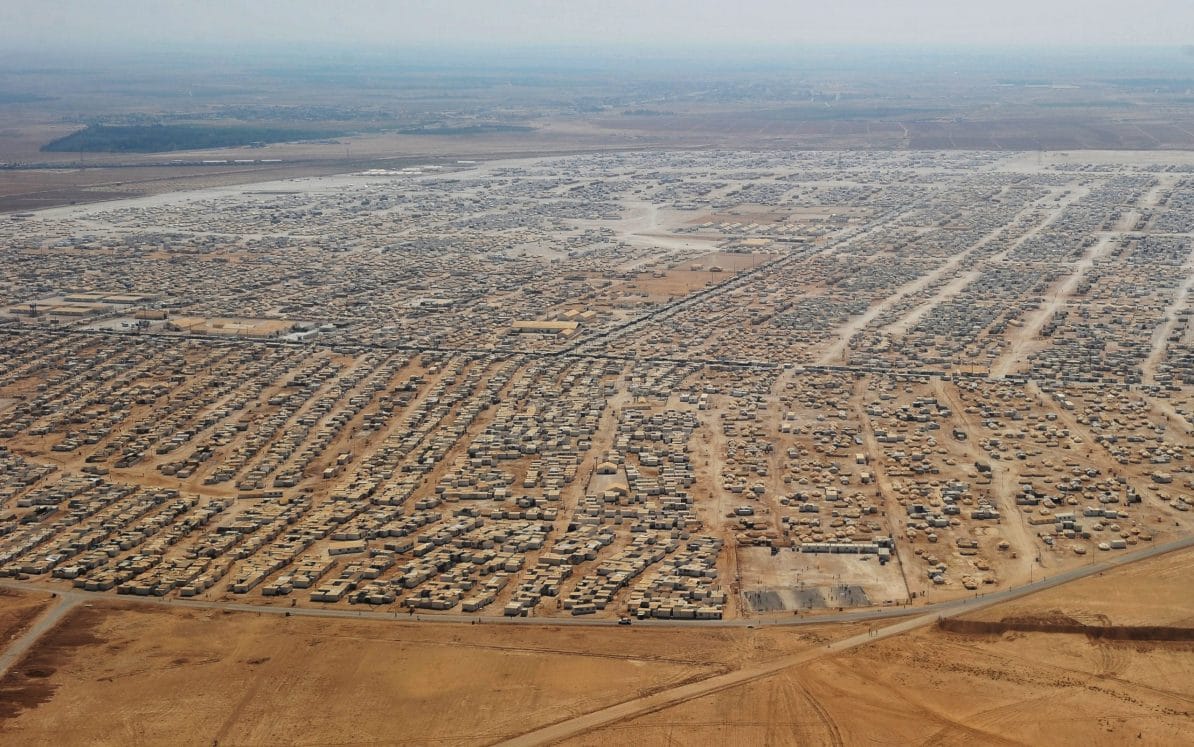
Photo: Mandel Ngan/AP/Press Association Images
1st December 2014 (Taken from: #17)
It was the news that the residents of Zaatari had long feared. The UN World Food Programme (WFP) had announced that its food voucher programme would have to be halted due to a chronic lack of funding. The UN itself warned that the results would be “devastating”, a fact that those living in one of the world’s largest refugee camps understood only too well. The stamps were not just simply a way of staving off hunger, they were the lifeblood of a thriving micro-economy. They were the tickets that changed a collection of tents a few miles from the Syrian border into a do-it-yourself metropolis, a testament to people’s desire to find normality in the most incredible of situations. And without them the refugees feared everything they had built would be lost. That the dark days would return.
A prison in the desert
I first visited Zaatari in 2012, three months after it opened. At that time, it was exactly how you’d imagine a refugee camp to look: thousands of white tents stamped with the UNHCR logo standing in neat rows in the desert. This was an emergency relief project. There was a reception area where new arrivals queued up for their basic rations: a blanket, a bucket and a few other essentials. There were hospital tents run by foreign volunteer doctors. And the World Food Programme was handing out meal boxes every day. This was a place that was meant to be a temporary refuge, a shelter just outside the danger zone. Security at the camp was tight. Very tight. Not only were the Jordanian authorities worried about infiltrators from the Syrian regime coming in to wreak revenge, they were also nervous about refugees leaving. If Syrians could come and go freely, the Zaatari refugee camp could become a regrouping base for rebel battalions, turning this chunk of Jordanian territory into a target for the Syrian regime. There was a Jordanian tank at the main gate, and police searches and ID checks at the second gate.
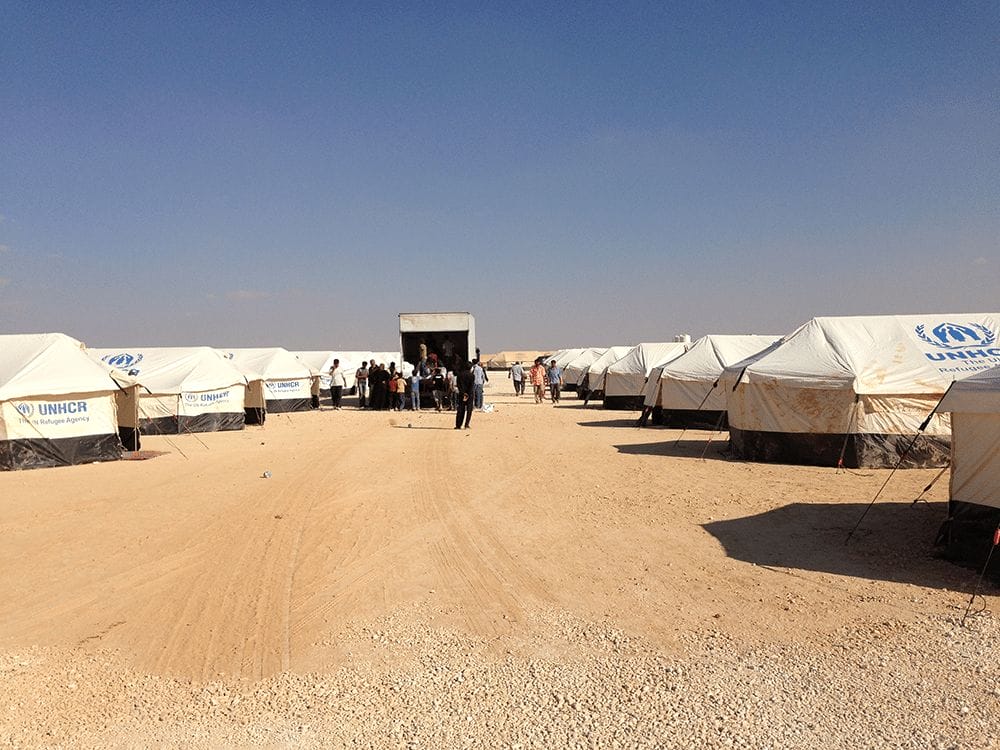
A quiet Zaatari camp three months after it opened to Syrian fleeing violence in July 2012. Photo: Sakhr Al-Makhadhi
As I drove through this second security check, a policeman told me to park my car out of sight. “They’ll throw stones at you,” he warned. It became clear that the Jordanians were scared of the 30,000 Syrian refugees under their control.
The feeling was mutual. Just past the main entrance was a parking area, where two buses were revving their engines noisily. Dozens of men and women were clamouring to get on board the vehicles, pleading to be allowed to leave. Their destination: Syria.
The refugees saw Zaatari as an internment camp. They felt trapped, and their only way out was to take a bus back into the war zone. What’s more, they believed they were being mistreated by the Jordanians and the international organisations caring for them. These were proud farming families forced to camp out in the desert with no money and to live on food handouts that they said were inedible. They were given a pizza box of pre-packaged rations and cartons of juice every day.

Kids at the Zaatari refugee camp assist with a food delivery in 2012. Photo: Sakhr Al-Makhadhi
Zaatari was a holding pen, and there were no permanent facilities. The showers were unfinished breezeblock rooms, and the only commerce was children kneeling behind cardboard boxes selling cigarettes. One enterprising man had set up a falafel stand using a gas canister and a pot of oil.
I met the Howshan family on road one, fourth tent on the left. As I walked past their living quarters, they almost pulled me inside, so desperate were they to talk to someone. Life in the camp was very, very boring. They weren’t allowed out, and at that time there were no activities, no work, no play. Nothing to do but sit around talking. A new face was a godsend.
Their tent was a dirty yellow colour and they’d put bricks around the entrance in a futile attempt to keep the sand out. Mattresses lined the sides, and a curtained-off area at the back was used as the washroom. They stood on pallets to clean themselves with buckets of cold water.
As we sat cross-legged on the floor outside their tent, they showed me videos on their mobile phones of massacres they said were committed just across the border. They complained about the prison-like treatment meted out by the camp authorities, even joking that the Jordanians were working for the Assad regime. Unfortunately for the Howshans, a Jordanian charity worker was walking past their tent and overheard our conversation. He decided to check that they weren’t insulting their host country. The conversation quickly turned into an argument, with the charity worker accusing them of lying.
That wasn’t a one-off event. I told a Jordanian employee of an international charity about the refugees’ complaints of dirty drinking water. “Of course,” she told me, “we’re in a desert.” She accused the refugees of wasting precious drinking water to wash their clothes.
There was open hostility on both sides. To the Jordanians, the refugees were wasteful, dangerous and ungrateful. And to the refugees, the Jordanians were prison guards, providing inedible food and boring them to death.
The conditions soon led to protests. The Howshans showed me a burnt-out cabin. They said the fire was started during a demonstration that followed two days of inedible food and undrinkable water. It’s claimed that the authorities closed off the main road, sent in 300 police officers, and tear-gassed the crowd. The clashes continued on a regular basis; several months later, a Syrian woman was reported to have been shot dead. The UNHCR said it happened when some refugees tried to flee the camp.
As I left, buses continued to stream out of Zaatari, heading back into Syria. They might not have been safe back home, but at least they were free.

In 2012, shopping options in Zaatari amounted to a handful of people sitting with their goods by the side of the dusty roads. A year later, there were 2,500 shops including 680 large stores. Photo: Sakhr Al-Makhadhi
“Syria now exists beyond its borders”
In 2012, the two words that defined Zaatari were tension and return. Both sides thought the war to overthrow the Syrian regime would be short, and that Zaatari would be temporary. Everyone thought the refugees would soon be going home to a free Syria. A year later, they were still there, and they’d been joined by thousands more.
When I went back to Zaatari in the autumn of 2013, the camp had quadrupled in size, to around 120,000 people – although neither the UN nor Jordan knew exactly how many were living there. At that time it was the fourth largest refugee camp in the world. Standing at the top of one of the hills in the camp, I could see the lights stretching out to the horizon.
But growth wasn’t the biggest change the camp had gone through – the real change was the increasing permanence of the place. Zaatari started life as thousands of tents hastily erected in the desert. It had become a Syrian city in exile.
Gone were many of the tents, replaced by portacabins, or – as refugees and aid workers called them – “caravans”. These little pre-fab houses were intended to offer more protection against the harsh winter weather after floods had washed away some of the tents the year before. The caravans were an investment in Zaatari’s future, an acceptance by the aid community that the city’s Syrian residents would be spending more winters in the desert.
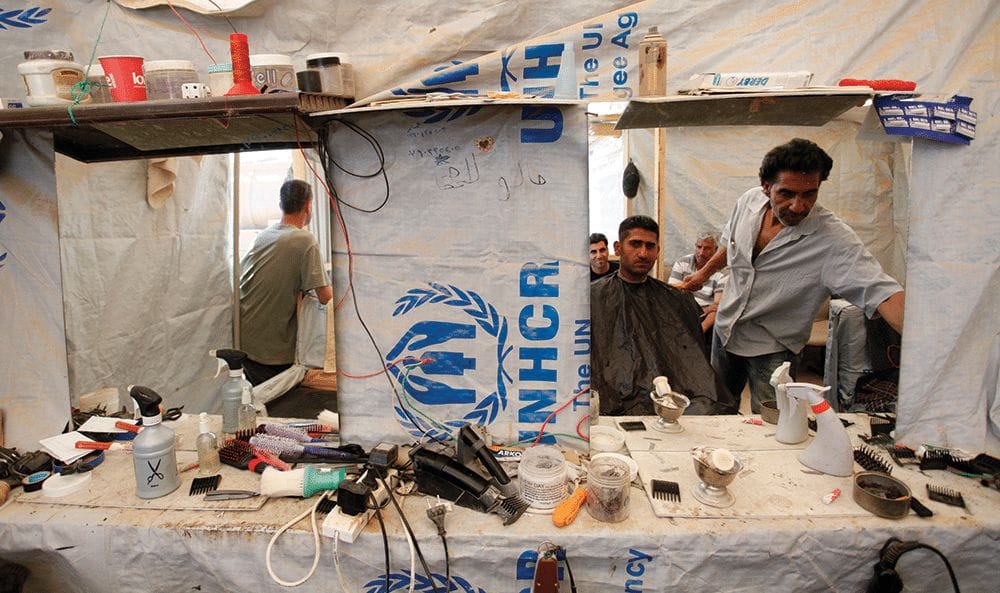
Abd al-Raouf Abo Majd, 45, right, known as ‘the Zaatari barber’, cuts a Syrian refugee’s hair in his UNHCR tent barbershop, at Zaatari refugee camp on 25th April 2013. Photo: Mohammad Hannon/AP/Press Association Images
The refugees, too, had come to accept the long-term nature of their stay here. They were creating gardens, putting flowers outside and installing water features. They weren’t just building homes, they were building a city. Some ingenious refugees had found ways of moving the caravans, and were reshaping the camp so that family and friends could live in communities. They ripped apart the grid-like UN system and designed their own metropolis.
At the heart of that city was one of Jordan’s largest souks. A year before, it was little more than one man’s falafel stand and a few kids kneeling behind a few cardboard boxes selling sweets and cigarettes. Now there were 2,500 shops, including 680 large stores. There was a 65 percent employment rate in the camp. Residents ate half a million pieces of bread a day and used half a million dollars of electricity per month. Zaatari had developed from a boring prison camp into a vibrant economic space.
The Zaatari economy was fuelled by the UN. The World Food Programme had swapped those despised boxes of inedible food for vouchers that could be spent in many of the camp’s shops. The vouchers were a UN cash injection into the camp, providing spending power and funding employment.
The camp was more open and more integrated into Jordan. Its economy was drawing in goods and employees: Jordanians were supplying it with food and consumer products, from fish tanks to fans and cellphones to computer games. Jordanians were also sneaking in to work illegally.
But what really struck me was the way the relationship between aid workers and refugees had changed. And much of that was down to one man: Kilian Kleinschmidt, the UN official sent in to turn the camp around.
“A year ago, it was a storage place where we all did wonderful work in keeping people alive and providing them with basic assistance,” he told me. “[These were] people who a year ago thought they’d be returning [to Syria] very fast. They became very frustrated when they realised they had to spend the winter [here]. My staff, six months ago, were scared, traumatised. We had people injured by stone throwing. There was one distribution of hygiene items that ended up with six humanitarian workers injured, four vehicles smashed. Here within the base camp, we wouldn’t be able to stand like this during the day, there were stones coming in.”
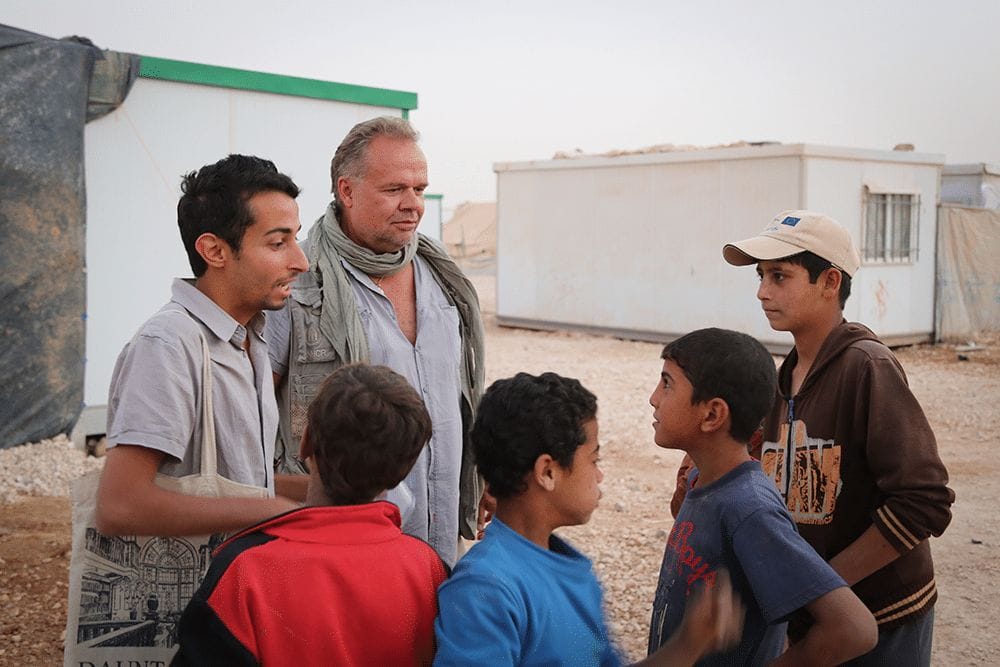
UN official Kilian Kleinschmidt and journalist Sakhr Al-Makhadhi talk to some of Zaatari’s younger residents in 2013. Photo: Sakhr Al-Makhadhi
Kleinschmidt did things that really scared the UN bureaucrats and his security team. He’d sleep in the camp, in one of the caravans. And he’d go for regular walks around Zaatari at night, unprotected.
Kleinschmidt agreed that I could join him on one of his night-time trips around the camp. The idea, he told me, was to be available to refugees, and to show them he was human. He would listen to people’s concerns, and eat in one of the Syrian-run Portakabin restaurants on the main market street.
We left base camp (a kind of green zone where the UN and other international organisations have their makeshift offices) at dusk, and Kleinschmidt weaved in and out through the maze of Zaatari’s sand “roads”. We were in almost total darkness, leaping over flooded potholes, and within minutes, children were rushing up to him to give him high-fives. Men came out of their caravans to greet him and hug him. If I’d been watching this scene on TV, I’d have thought it was a set-up, so different was it to the year before.
Almost all of the Syrians who approached him to chat jovially asked one of two questions: “When will we move into a caravan?” (at that point, around one-third of refugees were still in tents), and “When are you going to fix the electricity?” (the lights had a habit of going out, so hastily constructed was the grid).
If Syrians were building their city, then Kleinschmidt was their wildly popular mayor. He succeeded in turning around perceptions of the camp. No longer was this a place to flee, this was a place to come back to: Syrians who had escaped the camp to live in other parts of Jordan were returning. This was Syria. It was no longer a place where Syrians were camping out for a few weeks before returning to their homes. Syria now existed beyond its borders.
After the Arab Spring
The way that attitudes in Zaatari changed between 2012 and 2013 says something about the trajectory that the Syrian revolution has taken. In the early days of the uprising, activists and journalists would predict that Syrian president Bashar Al-Assad would be gone within three months, within six months, by the end of the year, before the summer. But that language started to dry up around the start of 2013, coinciding with a series of military victories by the Syrian army, assisted by Hezbollah.
The way the Assad regime turned this war around is symptomatic of a broader victory for counter-revolutionary forces across the Arab world. In November 2014, a court in Egypt cleared deposed dictator Hosni Mubarak of all charges against him in relation to the killing of protesters during that country’s 2011 revolution. That legal move came a year after Mubarak’s friends in the army overthrew the country’s first democratically elected president.
In Bahrain, Saudi Arabia has effectively taken over the state to prop up the king, who was facing a rebellion. In Yemen, the ousted president has returned to the country and it’s thought he could be partly to blame for the collapse of the government in January 2015. The Yemeni capital was covered in posters of the ex-president’s son: some have suggested he’s being groomed for power.
Kleinschmidt has now left Zaatari to launch his own NGO, the Innovation and Planning Agency. He calls it a matchmaking agency, created to bring together private sector cash, creative technology and aid workers to help marginalised communities. One of the projects he’s supporting is a biogas project in Jordan, another aims to make prosthetic limbs on 3D printers.
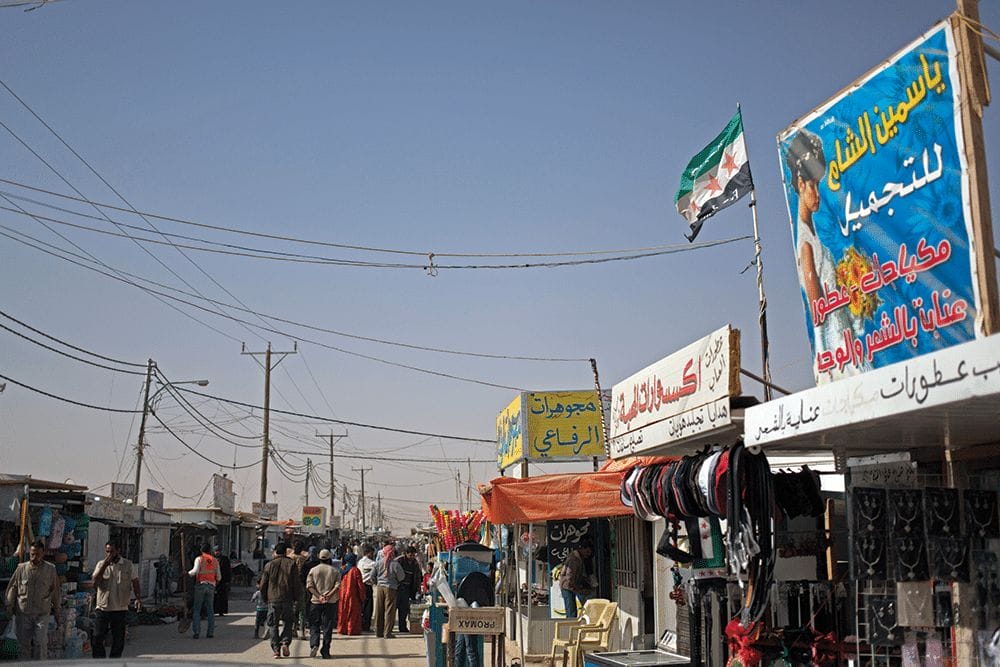
Syrian refugees and aid workers mix on a market street in Zaatari in April 2014. Photo: Khalil Hamra/AP/Press Association Images
He may have gone, but at Zaatari his energy lives on. Ninety-four percent of residents are now in caravans, and there’s been major work on the electricity grid. Many of the wires have been buried underground, making the system safer and more reliable, and almost all of the camp now has access to power. The souk has also continued to expand. Kleinschmidt’s favourite restaurant has been bought out by a refugee-investor, a flashy new sign has gone up outside and a Damascene-style courtyard fountain has been installed inside.
“The sense of community in Zaatari has grown,” says Aoife McDonnell at the UNHCR office in Amman of the refugees’ financial and emotional investment in the camp. “I saw one resident recently, and he said, ‘If we decide to stay here, [we’ll turn Zaatari] into a new Dubai.’”
“They’re helping to improve the way the camp is run,” she says. Refugees and aid workers sit on joint committees, which has helped defuse tension between the two sides. The Jordanian authorities have also done their bit to make life better. “There have been improvements in the community policing,” says McDonnell. “They’ve undergone specialist training. And that’s helped a lot, because many of the refugees had trust and authority issues.”
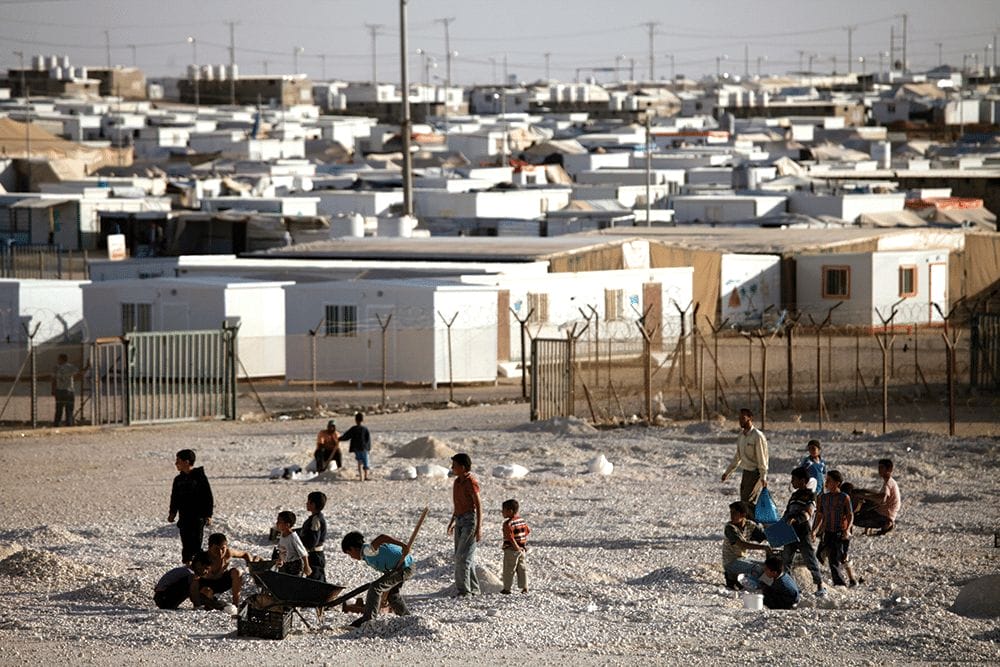
Syrian refugees work in the gravel yard, which is used to help protect their homes from rainwater. Photo: Mohammad Hannon/AP/Press Association Images
But the UN is keen for Zaatari not to grow much bigger than its current size. Instead, refugees are being sent to a new camp, Azraq, which opened in March 2014. “We learned lessons from Zaatari. It took us a year to plan Azraq – it’s very unusual for the UNHCR to have that much time, but we could see that the situation in Syria wasn’t improving,” says McDonnell. And with time came the ability to be much more innovative than in an emergency-response situation. “Azraq is a completely different type of camp.”
Azraq is built on an area of wetlands, with the accommodation planned around the streams. “We’ve got a decentralised village system with six shelters in each plot. Each village has got everything the community needs: a clinic, a school, a community centre.”
In Zaatari, some of the refugees were so unhappy that they were housed away from their friends and relatives that they would move caravans around the camp. In Azraq, the UN is trying a creative solution to the problem. “We’re applying a hotel reservation system to the refugee camp,” says McDonnell. “For example, if you cross [from Syria into Jordan] in early January, and you know that your brother is going to leave Syria in two weeks, you can reserve a neighbouring shelter for him. That keeps families together.”
So far, 12,000 Syrians have been housed in Azraq, and they’re some of the most vulnerable refugees to have entered Jordan because many of them are recent arrivals. “They stayed in Syria much longer, so we’re seeing nutrition problems. Often mothers have given birth with no antenatal care, so we need to offer them more care at Azraq, and we can do that because the camp is smaller.”
While Azraq is built on the lessons that aid workers learned at Zaatari, the new camp has two distinct disadvantages, both because of its location. First: climate. It may be wetland, but Azraq is deeper into the desert than Zaatari, and so the extremes of hot and cold are much greater. And second: electricity. While nearly everyone in Zaatari has power, Azraq is off the grid.
“We’ve got solar lighting in places, funded by Ikea. That’s very important for protection. But we’ve struggled to find a donor for the electricity,” says McDonnell. “We may be able to start work [on an electricity system] this summer.”
And when that does happen, the UN expects Azraq’s size to grow. “We’ve had Syrian refugees arriving from urban areas [in Jordan] with fridges and TVs in the back of their cars,” she says. “We tell them that there’s no electricity and they say, ‘Oh yes, we know, but we’ve heard that you’re going to be putting cables in.’ So when that happens, we might expect more urban refugees coming in.”
The reprieve
On 9th December 2014, just over a week after the WFP’s potentially catastrophic announcement, the food voucher scheme was reinstated. A “massive expression” of support from the public, the private sector and donor countries saw WFP overtake its initial fundraising goal of $64 million and hit $80 million by the end of 2014. The financing means that the tickets will continue and the Zaatari economy is safe, for now. It remains to be seen whether the funds will outlast the war.
“We used to see hundreds of refugees cross into Jordan refusing to register [with the UN] or even take a blanket,” says McDonnell. “Refugees used to say, ‘Tomorrow will be the day we go home.’ But there’s now a belief among the refugee population that they won’t be going home in the near future.”
While the old guard is fighting back from the palaces and parliaments of the Arab world, destroying towns and cities with renewed vigour, the refugees of Zaatari are rebuilding: not just their lives, but a new Syria, here in the desert.
Slow Journalism in your inbox, plus infographics, offers and more: sign up for the free DG newsletter. Sign me up
Thanks for signing up.

